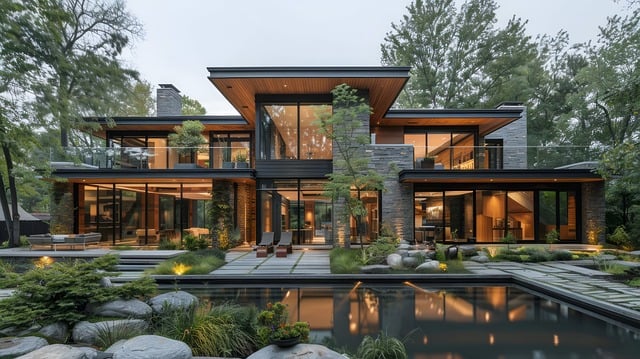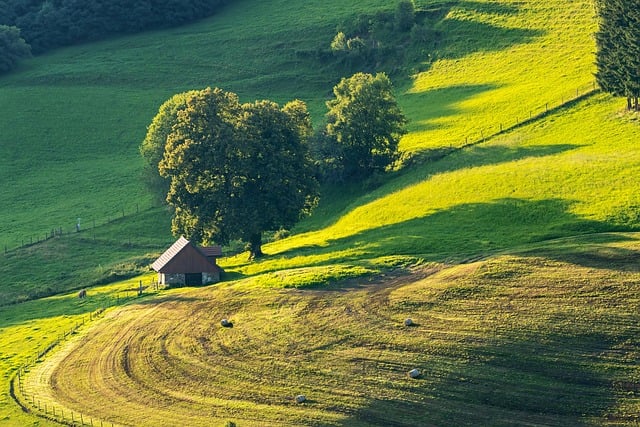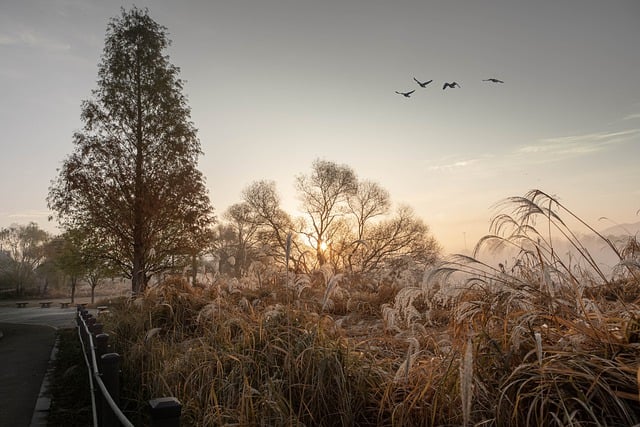This section discusses the integration of functional landscaping with pet-friendly elements to enhance the well-being of pets and improve home aesthetics. It recommends designing an outdoor space that caters to pets' needs for shade, play areas, and safety by selecting non-toxic plants like Bermuda grass, Kentucky bluegrass, fescue, and flowers such as black-eyed Susans, marigolds, and zinnias. Importantly, it advises avoiding toxic plants like lilies, sago palms, and azaleas. The design should include secure fencing, shaded retreats, pet amenities like water features and maintenance stations, and use of durable, non-toxic materials for longevity and ease of maintenance. Interactive elements that cater to pets' natural behaviors, such as digging zones and agility equipment, are encouraged to provide mental stimulation and physical activity. Additionally, the section emphasizes the importance of year-round maintenance, including regular inspections for hazards, organic fertilization, and pest control methods safe for pets, trimming the lawn to deter pests, selecting drought-resistant plants for local climate conditions, proper tree and shrub maintenance to prevent injury, and ensuring good drainage to maintain soil health and pet safety. By adopting these practices, homeowners can create a sustainable, healthy, and engaging outdoor environment that benefits both their pets and the overall landscape.
Embark on a journey to transform your outdoor space into a pet-centric haven with functional landscaping. This article delves into crafting a tailored landscape that not only thrives but also caters to the well-being of your furry companions. From selecting pet-friendly plants to designing secure and enriching outdoor areas, learn how to integrate interactive elements for mental stimulation. With maintenance tips ensuring year-round vitality, your pets can safely enjoy a lush and inviting environment. Dive into the world of pet-focused landscaping to create a harmonious outdoor retreat for both you and your beloved animals.
- Understanding Functional Landscaping for Pet Owners
- Pet-Friendly Plant Selection for a Safe and Healthy Outdoor Space
- Designing Outdoor Pet Areas: Enclosure Considerations and Features
- Integrating Interactive Elements to Stimulate Pet Mental Health
- Maintenance and Safety Tips for a Thriving Pet Landscape Year-Round
Understanding Functional Landscaping for Pet Owners

Incorporating functional landscaping into your outdoor space can significantly enhance the well-being of your pets while complementing the aesthetic appeal of your home’s landscape. This approach involves designing an environment that caters to your furry companions’ needs, such as providing shaded areas for comfort during warmer climates, and ensuring a safe, secure, and stimulating area for them to roam and play. By integrating pet-friendly plants and creating designated spaces for activities like digging or lounging, you can foster a harmonious relationship between your pets and the surrounding landscape. Additionally, thoughtful landscaping choices can mitigate common pet-related issues such as soil erosion from excavation and eliminate hazardous elements that could pose a threat to their health.
For pet owners committed to maintaining a lush and vibrant landscape, selecting pet-safe plants is paramount. These landscaping choices not only prevent potential poisoning but also promote a safe and enriching outdoor experience for your pets. A well-designed pet-friendly landscape includes a variety of textures, scents, and sights that cater to the curiosity and playfulness of animals. Furthermore, including pet amenities such as water features, easy-to-clean stations, and secure fencing within the landscape design ensures a comfortable and safe environment for your pets’ daily activities. This thoughtful integration of function and form in landscaping not only supports the health and happiness of pets but also contributes to the overall tranquility and beauty of the yard.
Pet-Friendly Plant Selection for a Safe and Healthy Outdoor Space

When designing a functional landscape for pets, selecting the right plants is paramount to ensure a safe and healthy outdoor space for your furry companions. Opt for pet-friendly plant species that are less likely to cause gastrointestinal upset or other health issues if ingested. For instance, grasses such as Bermuda, Kentucky bluegrass, and fescue are excellent choices for creating a lush green area where pets can play and rest. Additionally, consider incorporating easy-to-maintain perennials like black-eyed Susans, marigolds, and zinnias, which not only add vibrant colors but also tend to be non-toxic to pets.
In the realm of landscaping for pets, it’s crucial to avoid plants that are known to be toxic or harmful. Common household plants like lilies, sago palms, and azaleas can pose significant risks to your pet’s health if consumed. Therefore, a thoughtful approach to plant selection, focusing on the safety and well-being of your pets, will create a harmonious outdoor space that both you and your animals can enjoy. By carefully selecting non-toxic plants and designing a pet-friendly landscape, you can foster an environment where your pets can safely explore and interact with their natural surroundings.
Designing Outdoor Pet Areas: Enclosure Considerations and Features

Incorporating pet-friendly elements into your landscape design can create a harmonious outdoor space that both you and your furry companions will enjoy. When designing an enclosure for pets, it’s crucial to consider their safety, well-being, and the types of activities they enjoy. The enclosure should be secure, preventing escape and protecting your pet from potential hazards such as traffic or toxic plants. Landscaping features like fencing with a height that keeps out larger animals while allowing smaller pets to safely explore should be prioritized. Additionally, the inclusion of shaded areas, pet-safe plants, and soft ground covers can provide comfort and reduce the risk of injury or sunburn. Water features can be both aesthetically pleasing and functional, offering pets a source of fresh water and a cool retreat on warm days.
Furthermore, integrating elements that cater to your pet’s natural behaviors, such as digging areas with appropriate landscaping materials, can mitigate unwanted destruction to your yard. Interactive features like pet-friendly agility equipment or scratching posts can stimulate mental and physical health. Landscaping with durable, non-toxic plants and creating distinct zones within the enclosure for rest, play, and relaxation will ensure a well-rounded outdoor experience for your pet. It’s essential to use weather-resistant materials that require minimal maintenance and are safe for pets, enhancing both the longevity of the landscaping and the quality of time spent outdoors.
Integrating Interactive Elements to Stimulate Pet Mental Health

Incorporating interactive elements into pet-friendly landscapes plays a pivotal role in enhancing their mental wellbeing. Strategic placement of scent trails, using native plants with distinct aromas, can engage a pet’s olfactory senses, providing mental stimulation and enrichment. Additionally, the integration of various textures and materials, such as natural stone or water features, offers tactile experiences that can keep pets mentally engaged and physically active. These landscaping choices not only serve to entertain and stimulate but also contribute to a more dynamic and pet-centric outdoor environment.
Furthermore, landscapes designed with pets in mind often include agility obstacles or hidden nooks for playful exploration. These features encourage physical activity, which is beneficial for a pet’s overall health, and provide opportunities for problem-solving and cognitive development. Landscaping elements such as low-hanging branches for climbing, tunnels to traverse, and scent marking areas can all be thoughtfully integrated into the yard to cater to a pet’s natural behaviors and instincts, ensuring a harmonious and stimulating outdoor space tailored specifically for them.
Maintenance and Safety Tips for a Thriving Pet Landscape Year-Round

When designing a pet-friendly landscape that thrives year-round, maintenance and safety are paramount to ensure your furry friends have a healthy environment to enjoy. Regularly inspect your landscaping for hazards such as sharp objects, toxic plants, or pesticide use, which can pose risks to pets. Safe alternatives to chemical treatments, like organic fertilizers and natural pest control methods, should be employed to minimize potential harm. Additionally, keeping the grass trimmed and clean can prevent fleas and ticks from taking up residence in your yard, benefiting both your pet’s comfort and health.
To maintain a lush and pet-safe landscape throughout the seasons, consider the specific needs of your local climate and the types of plants you choose. For instance, drought-resistant shrubbery can reduce watering needs during dry spells while still providing a safe retreat for pets. Regular pruning and deadwooding of trees and shrubs not only maintain aesthetics but also prevent injury to pets from sharp branches. Moreover, ensuring proper drainage to manage rainfall will keep the soil healthy and prevent standing water that can be breeding grounds for mosquitoes, which are a nuisance and potential carrier of disease. By prioritizing these maintenance and safety measures in your pet landscape design, you can create a sustainable and enjoyable outdoor space for your pets all year long.
In conclusion, functional landscaping is not just about aesthetics; it’s about creating a safe, engaging, and healthful environment for pets. By selecting pet-friendly plants and designing thoughtful outdoor spaces with enclosures that cater to their needs, pet owners can ensure their furry friends have a place to thrive. Interactive elements that stimulate mental health are crucial for keeping pets happy and well. Regular maintenance and adherence to safety tips are essential for maintaining a vibrant pet landscape throughout the year. With these considerations in mind, pet owners can transform their outdoor spaces into functional landscapes that provide both beauty and functionality, enhancing the lives of their pets while complementing their own homes.
